Mission: Protect the white rhino
Although rhino horns have no medicinal properties, poachers continue to hunt these animals. EL PAÍS traveled to Kruger National Park in South Africa to see the efforts of conservationists and brands such as Hublot to keep them alive
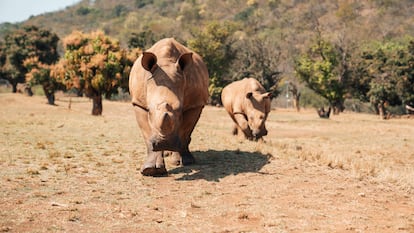
The helicopter’s blades cut through the air in heavy, monotonous bursts of sound. It’s just after 7:30 a.m. and the sun is already up, but it’s still not hot enough to be punishing. The landscape — filled with dry bushes, due to winter — makes the job of Marius, the helicopter pilot, easier. His eyes have detected a white rhinoceros in the middle of the savannah of South Africa’s Kruger National Park.
He notifies the crew. From the helicopter, one of the park rangers takes a rifle and shoots at the animal. On the first try, the rhino is hit. He growls, but the sound is drowned out by the noise of the propellers. The rhino stumbles through the bushes, as if without understanding what’s happening. Suddenly, he collapses.
The helicopter lands, kicking up wind that’s full of sand and dry grass. When the propeller stops rotating, a team of several rangers, two veterinarians and Marius descend. They run towards the rhino. He’s not dead: he’s only asleep. They haven’t killed him — they’re saving his life.

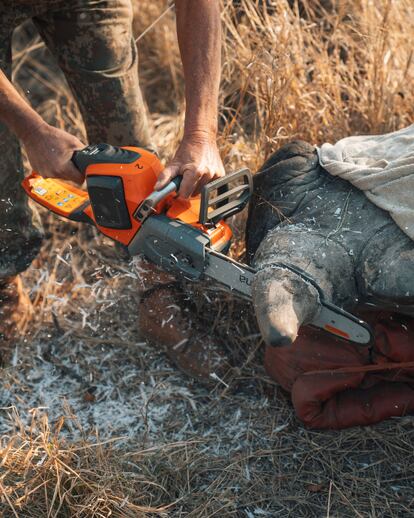
The team works fast. They know that they have little time — the work they’ve come to do is expensive. The first thing they do is cover the rhino’s eyes with a towel and use ropes to immobilize him. Afterwards, they measure his horn and, with the help of a device, they look behind his ears and along his neck, to see if there is a microchip. The rhino doesn’t move — he breathes heavily and, from time to time, growls again. He’s a young male specimen, which means that his horn grows at a faster rate than other rhinos. In pregnant females, the horn barely grows, because all their energy is dedicated to their offspring.
Suddenly, the growls stop. Marius has a giant electric saw in his hands as he approaches the animal’s horn. He cuts it, causing hundreds of splinters of keratin to fly onto the ground.
Rhinoceros horns have absolutely no miraculous, or even beneficial, properties. Still, they’re revered among certain consumers in Asian countries, such as China or Vietnam. In those parts of the world, for centuries, many have thought that when a white rhino’s horn is turned into powder, it can cure everything from hangovers to cancer. At the same time, having a whole horn from an adult specimen can be interpreted as a sign of wealth. On the black market, the price of rhino horn reaches $30,000 per pound… more expensive than cocaine.
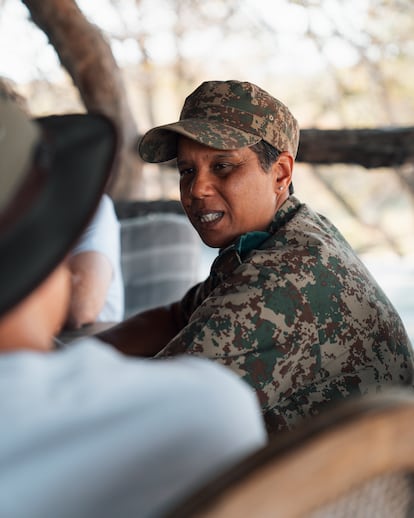
“We have a huge border with Mozambique, much of it open, where poachers enter. Mozambicans are paid by criminal groups by [the pound], so they tear off the horn even if it’s small. Most of these hunters are very poor people,” Cathy Dreyer notes. She’s the first-ever female chief of the park rangers at Kruger National Park since its founding.
Dreyer has been dedicated to the protection of rhinos for more than 21 years — practically her entire working life. She started as part of a team similar to the one that accompanies Marius in the helicopter, but in Kimberley, in the center of South Africa. “I stayed there for 13 years, but I got really tired of living in a sleeping bag and a tent, because we spent eight months on the road and four at home.” Thus, Dreyer joined the team at Kruger National Park six years ago. And, two years ago, she became the boss.
Generally, the average day of a ranger consists of getting up at 4 a.m. and working until the sun sets. Kruger National Park is more than 7,000 square miles in total area, or the same size as the island of Fiji. It’s an extensive territory made up of baobab trees and bushes that’s difficult to keep under control. “Getting from one end of the park to the other can take a whole day if you go by car,” Dreyer explains.
Kruger employs about 2,500 people. Of them, only 386 are rangers… too few to keep dozens of poachers at bay in such a vast territory. In 2011, the park was home to a population of 10,621 white rhinos. In 2022, there were only 2,225 left. In the first six months of 2023 alone, 42 rhinos were killed by poachers in the national park.
“It’s up to the park rangers to track the poachers, sometimes all day long,” Dreyer says. “We have dogs to sniff out the trail, license plate recognition cameras hidden behind bushes, and night vision goggles. [We’re even adapting] helicopters that can fly at night. We’ve improved, but so have the poachers. They are always one step ahead.” On many occasions, the capacity of poachers is due to nothing more than help — a tip-off — from within the ranks of the rangers themselves: “40% of the staff are reportedly involved in poaching,” Dreyer laments.
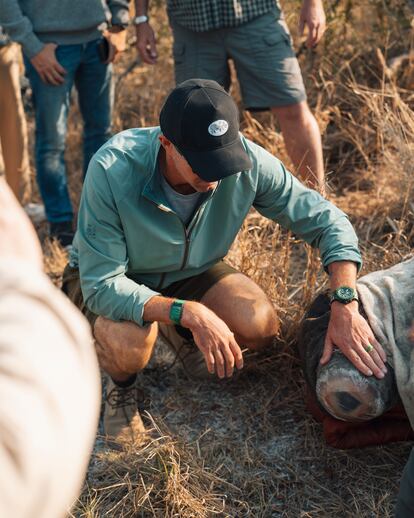
Upon taking office two years ago, she fired more than 40 rangers. “We had a regional ranger involved [with the poachers] a few years ago,” Dreyer says. She’s referring to Rodney Landela, who was a park worker for 15 years. All his colleagues saw him as the boss-in-waiting before Dreyer took over. In 2016, it was those same colleagues — who trusted Rodney — who discovered him fleeing the site where a dead rhinoceros lay. The bullet from his rifle was what had killed the animal; his bloody shoes left no room for doubt. The torn-off horn was found a few feet from the site. “We have a very serious problem with corruption and we’re only now beginning to understand how rangers end up in these mafia networks,” the head ranger at Kruger explains.
In general, the system is almost always the same: a ranger has a debt and ends up borrowing money from a loan shark. Loan sharks in South Africa are often involved in poaching and, when they find out where their client works, they don’t hesitate to blackmail them by using their family. For their part, the rangers know exactly where each animal is and the deployment schedules of their companions. They have weapons and the opportunity to remove the horn once the animal has been killed. “The rangers definitely don’t get paid enough in the park. A field ranger earns between 10,000 and 12,000 rand a month (about $650),” Dreyer admits. Poaching offers a good supplemental income.
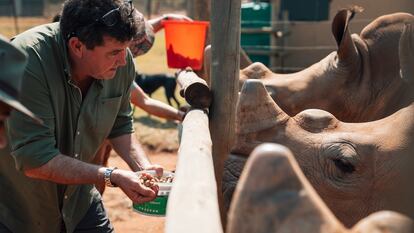
“The people who come here to kill are desperate. These are people who kill because they want to feed their children. Those who live here don’t understand why tourists come to photograph their food,” acknowledges Kevin Pietersen, a former cricketer and founder of SORAI, which is dedicated to providing monetary support for conservation work taking place in Kruger National Park. His organization is partnered with luxury brands such as Hublot, which has already released three watches dedicated to the protection of rhinos. Pietersen specializes in raising funds that are then allocated to schools to educate local children about how to protect animals, or to support the activities of rangers.
Dehorning a rhino — as Marius has done — involves the mobilization of a team of professionals and fuel for a helicopter. It costs about $2,000 per animal, a sum that the park doesn’t really have. On good days, they can dehorn up to 20 rhinos.
“Unfortunately, in South Africa, we don’t have a government that wants to strictly ban hunting,” Pietersen sighs. In fact, rhino hunting is legal in the country if you have a permit from the government (there are about 1,000 licenses issued annually). The international horn trade is prohibited, but the domestic trade is not.
After cutting off the rhino’s horn, Marius lets his team work. One of the veterinarians takes a stool sample and five tubes of blood that will later be analyzed in the laboratory. The severed horn rests next to him, on the ground. Its filed beak indicates that this specimen was already dehorned a few months ago. It’s soft and heavy: the freshly cut part shows a beige color with a dark gray center that forms the shape of a heart.
When all the measurements are finished, they release the rhino, who no longer grunts or kicks, but immediately stands up. Everything is over. In 18 months, when the horn grows back, the process will start again. That is, if the rhino doesn’t suffer the same fate as the 42 specimens who were killed by poachers in 2023.
“Many people ask me: ‘Why don’t we shoot and kill the poachers?’ I wish we could,” Dreyer admits, laughing. “But joking aside, the last thing I would want is for a ranger to be accused of murder and to end up in prison. If you have to shoot, let it be to immobilize [the person] — not to kill them.”

Sign up for our weekly newsletter to get more English-language news coverage from EL PAÍS USA Edition
Tu suscripción se está usando en otro dispositivo
¿Quieres añadir otro usuario a tu suscripción?
Si continúas leyendo en este dispositivo, no se podrá leer en el otro.
FlechaTu suscripción se está usando en otro dispositivo y solo puedes acceder a EL PAÍS desde un dispositivo a la vez.
Si quieres compartir tu cuenta, cambia tu suscripción a la modalidad Premium, así podrás añadir otro usuario. Cada uno accederá con su propia cuenta de email, lo que os permitirá personalizar vuestra experiencia en EL PAÍS.
¿Tienes una suscripción de empresa? Accede aquí para contratar más cuentas.
En el caso de no saber quién está usando tu cuenta, te recomendamos cambiar tu contraseña aquí.
Si decides continuar compartiendo tu cuenta, este mensaje se mostrará en tu dispositivo y en el de la otra persona que está usando tu cuenta de forma indefinida, afectando a tu experiencia de lectura. Puedes consultar aquí los términos y condiciones de la suscripción digital.
More information
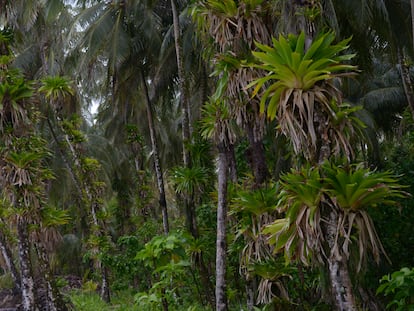
Are plant species also becoming extinct?
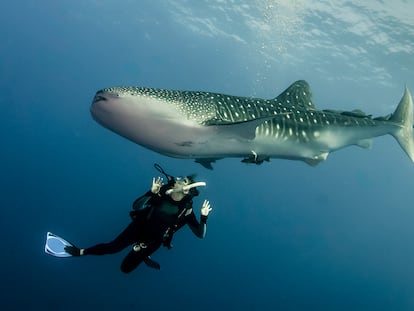
Misguided ecotourism may lead to changes in whale shark behavior
Archived In
Últimas noticias
Most viewed
- Reinhard Genzel, Nobel laureate in physics: ‘One-minute videos will never give you the truth’
- Oona Chaplin: ‘I told James Cameron that I was living in a treehouse and starting a permaculture project with a friend’
- Pablo Escobar’s hippos: A serious environmental problem, 40 years on
- Charles Dubouloz, mountaineering star, retires at 36 with a farewell tour inspired by Walter Bonatti
- Why we lost the habit of sleeping in two segments and how that changed our sense of time









































